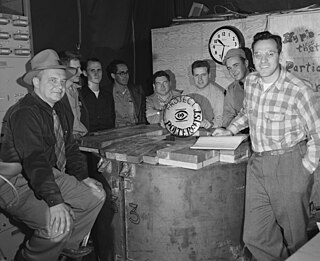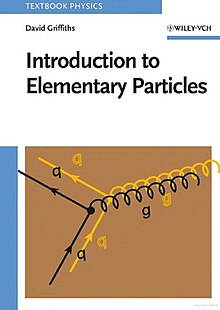
In particle physics, an elementary particle or fundamental particle is a subatomic particle that is not composed of other particles. The Standard Model presently recognizes seventeen distinct particles—twelve fermions and five bosons. As a consequence of flavor and color combinations and antimatter, the fermions and bosons are known to have 48 and 13 variations, respectively. Among the 61 elementary particles embraced by the Standard Model number: electrons and other leptons, quarks, and the fundamental bosons. Subatomic particles such as protons or neutrons, which contain two or more elementary particles, are known as composite particles.

In particle physics, quantum electrodynamics (QED) is the relativistic quantum field theory of electrodynamics. In essence, it describes how light and matter interact and is the first theory where full agreement between quantum mechanics and special relativity is achieved. QED mathematically describes all phenomena involving electrically charged particles interacting by means of exchange of photons and represents the quantum counterpart of classical electromagnetism giving a complete account of matter and light interaction.
A timeline of atomic and subatomic physics.

In physics, a subatomic particle is a particle smaller than an atom. According to the Standard Model of particle physics, a subatomic particle can be either a composite particle, which is composed of other particles, or an elementary particle, which is not composed of other particles. Particle physics and nuclear physics study these particles and how they interact. Most force carrying particles like photons or gluons are called bosons and, although they have discrete quanta of energy, do not have rest mass or discrete diameters and are unlike the former particles that have rest mass and cannot overlap or combine which are called fermions.

Julian Seymour Schwinger was a Nobel Prize-winning American theoretical physicist. He is best known for his work on quantum electrodynamics (QED), in particular for developing a relativistically invariant perturbation theory, and for renormalizing QED to one loop order. Schwinger was a physics professor at several universities.

David Jeffrey Griffiths is an American physicist and educator. He was on the faculty of Reed College from 1978 through 2009, becoming the Howard Vollum Professor of Science before his retirement. He wrote three highly regarded textbooks for undergraduate physics students.

The Cowan–Reines neutrino experiment was conducted by physicists Clyde Cowan and Frederick Reines in 1956. The experiment confirmed the existence of neutrinos. Neutrinos, subatomic particles with no electric charge and very small mass, had been conjectured to be an essential particle in beta decay processes in the 1930s. With neither mass nor charge, such particles appeared to be impossible to detect. The experiment exploited a huge flux of electron antineutrinos emanating from a nearby nuclear reactor and a detector consisting of large tanks of water. Neutrino interactions with the protons of the water were observed, verifying the existence and basic properties of this particle for the first time.
In particle physics, lepton number is a conserved quantum number representing the difference between the number of leptons and the number of antileptons in an elementary particle reaction. Lepton number is an additive quantum number, so its sum is preserved in interactions. The lepton number is defined by

In quantum field theory, a branch of theoretical physics, crossing is the property of scattering amplitudes that allows antiparticles to be interpreted as particles going backwards in time.

In particle physics, the history of quantum field theory starts with its creation by Paul Dirac, when he attempted to quantize the electromagnetic field in the late 1920s. Major advances in the theory were made in the 1940s and 1950s, leading to the introduction of renormalized quantum electrodynamics (QED). The field theory behind QED was so accurate and successful in predictions that efforts were made to apply the same basic concepts for the other forces of nature. Beginning in 1954, the parallel was found by way of gauge theory, leading by the late 1970s, to quantum field models of strong nuclear force and weak nuclear force, united in the modern Standard Model of particle physics.
Quantum mechanics is the study of matter and its interactions with energy on the scale of atomic and subatomic particles. By contrast, classical physics explains matter and energy only on a scale familiar to human experience, including the behavior of astronomical bodies such as the moon. Classical physics is still used in much of modern science and technology. However, towards the end of the 19th century, scientists discovered phenomena in both the large (macro) and the small (micro) worlds that classical physics could not explain. The desire to resolve inconsistencies between observed phenomena and classical theory led to a revolution in physics, a shift in the original scientific paradigm: the development of quantum mechanics.
Asım Orhan Barut was a Turkish-American theoretical physicist.

Classical Mechanics is a textbook about written by Herbert Goldstein, a professor at Columbia University. Intended for advanced undergraduate and beginning graduate students, it has been one of the standard references on its subject around the world since its first publication in 1950.

The Feynman Lectures on Physics is a physics textbook based on a great number of lectures by Richard Feynman, a Nobel laureate who has sometimes been called "The Great Explainer". The lectures were presented before undergraduate students at the California Institute of Technology (Caltech), during 1961–1963. The book's co-authors are Feynman, Robert B. Leighton, and Matthew Sands.

The Principles of Quantum Mechanics is an influential monograph on quantum mechanics written by Paul Dirac and first published by Oxford University Press in 1930. Dirac gives an account of quantum mechanics by "demonstrating how to construct a completely new theoretical framework from scratch"; "problems were tackled top-down, by working on the great principles, with the details left to look after themselves". It leaves classical physics behind after the first chapter, presenting the subject with a logical structure. Its 82 sections contain 785 equations with no diagrams.
Classical Electrodynamics is a textbook written by theoretical particle and nuclear physicist John David Jackson. The book originated as lecture notes that Jackson prepared for teaching graduate-level electromagnetism first at McGill University and then at the University of Illinois at Urbana-Champaign. Intended for graduate students, and often known as Jackson for short, it has been a standard reference on its subject since its first publication in 1962.

Introduction to Electrodynamics is a textbook by physicist David J. Griffiths. Generally regarded as a standard undergraduate text on the subject, it began as lecture notes that have been perfected over time. Its most recent edition, the fifth, was published in 2024 by Cambridge University. This book uses SI units exclusively. A table for converting between SI and Gaussian units is given in Appendix C.
Introduction to Quantum Mechanics, often called Griffiths, is an introductory textbook on quantum mechanics by David J. Griffiths. The book is considered a standard undergraduate textbook in the subject. Originally published by Pearson Education in 1995 with a second edition in 2005, Cambridge University Press (CUP) reprinted the second edition in 2017. In 2018, CUP released a third edition of the book with Darrell F. Schroeter as co-author; this edition is known as Griffiths and Schroeter.
The SLAC Theory Group is the hub of theoretical particle physics research at the SLAC National Accelerator Laboratory at Stanford University. It is a subdivision of the Elementary Particle Physics (EPP) Division at SLAC.










